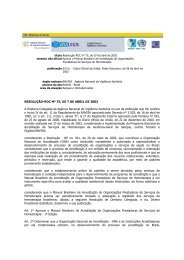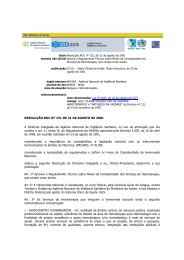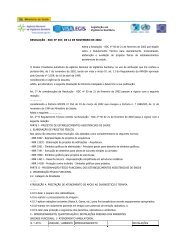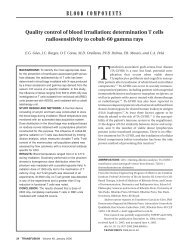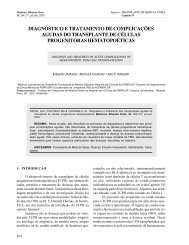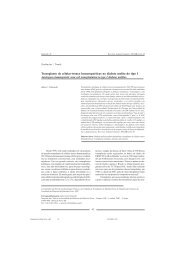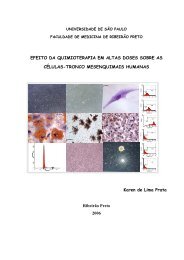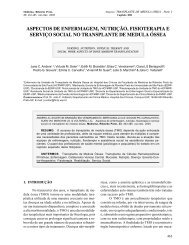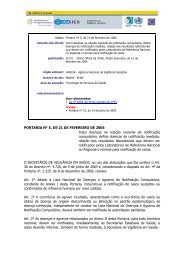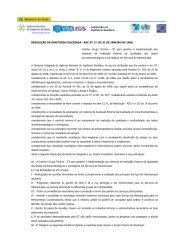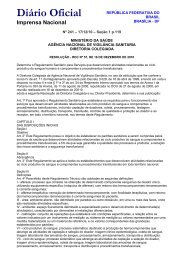- Page 3: AUTORIZO A REPRODUÇÃO E DIVULGAÇ
- Page 6 and 7: Aos pacientes transplantados,Doutor
- Page 8 and 9: Ao Laboratório de Biologia Molecul
- Page 10 and 11: “The marvelous richness of human
- Page 14 and 15: autoimmune disease, observed for th
- Page 16 and 17: Figura 16. Expressão de marcadores
- Page 18: Figura Q.1. Repertório da cadeia V
- Page 21 and 22: Tabela K.1. Freqüência individual
- Page 23 and 24: LISTA DE ABREVIATURAS E SIGLAS• a
- Page 25 and 26: SUMÁRIO1 Introdução ............
- Page 27 and 28: 1 Introdução
- Page 29 and 30: Introdução 3próprio”, com tinh
- Page 31 and 32: Introdução 5com alta afinidade no
- Page 33 and 34: Introdução 710% da população de
- Page 35 and 36: Introdução 9espontaneamente esta
- Page 37 and 38: Introdução 11(situado na região
- Page 39 and 40: Introdução 13de auto-antígenos d
- Page 41 and 42: Introdução 15taxa de concordânci
- Page 43 and 44: Introdução 171.4 Transplante de c
- Page 45 and 46: Introdução 19humana. Existem dois
- Page 47 and 48: Introdução 21antígenos do doador
- Page 49 and 50: Introdução 23Nesse estudo, as les
- Page 51 and 52: Introdução 25mecanismo, primeiram
- Page 53 and 54: Introdução 27se à proliferação
- Page 55 and 56: Introdução 29preferencialmente ex
- Page 57 and 58: 2 Objetivos
- Page 59 and 60: 3 Casuística, Material e Métodos
- Page 61 and 62: Casuística, Materiais e Métodos 3
- Page 63 and 64:
Casuística, Materiais e Métodos 3
- Page 65 and 66:
Casuística, Materiais e Métodos 3
- Page 67 and 68:
Casuística, Materiais e Métodos 4
- Page 69 and 70:
Casuística, Materiais e Métodos 4
- Page 71 and 72:
Casuística, Materiais e Métodos 4
- Page 73 and 74:
Casuística, Materiais e Métodos 4
- Page 75 and 76:
Casuística, Materiais e Métodos 4
- Page 77 and 78:
Casuística, Materiais e Métodos 5
- Page 79 and 80:
Casuística, Materiais e Métodos 5
- Page 81 and 82:
4 Resultados
- Page 83 and 84:
Resultados 57mortalidade precoce ca
- Page 85 and 86:
Resultados 59transplante. Nenhum pa
- Page 87:
Resultados 61Tabela 6. Avaliação
- Page 91 and 92:
Resultados 65A diferença de capaci
- Page 93 and 94:
Resultados 67intensa proliferação
- Page 95 and 96:
Resultados 69aumentou após o TACTH
- Page 97 and 98:
Resultados 71D+360, respectivamente
- Page 99 and 100:
Resultados 73A2500B18001600Linfóci
- Page 101 and 102:
Resultados 75A800B800T CD4+CD27+CD4
- Page 103 and 104:
Resultados 77AB% Linfócitos T CD3+
- Page 105 and 106:
Resultados 79A% Linfócitos T CD4+C
- Page 107 and 108:
Resultados 814.2.2 Pacientes com es
- Page 109 and 110:
Resultados 83O número absoluto das
- Page 111 and 112:
Resultados 85porcentagem de célula
- Page 113 and 114:
Resultados 8771,5%, 58,6%, 59,5%, 6
- Page 115 and 116:
Resultados 89A3000B1800Linfócitos
- Page 117 and 118:
Resultados 91A800B1200CD4+CD27+CD45
- Page 119 and 120:
Resultados 93AB% Linfócitos T CD3+
- Page 121 and 122:
Resultados 95A% Linfócitos T CD4+C
- Page 123 and 124:
Resultados 974.3 Avaliação do per
- Page 125 and 126:
Resultados 99transplante, houve um
- Page 127 and 128:
Resultados 101AT CD4 + T CD8 +B% C
- Page 129 and 130:
Resultados 103A Figura 22E mostra u
- Page 131 and 132:
Resultados 105AT CD4 + T CD8 +B% C
- Page 133 and 134:
Resultados 107diabete melito do tip
- Page 135 and 136:
Resultados 1094.4.1 Pacientes com d
- Page 137 and 138:
Resultados 111Tabela 7. Análise da
- Page 139 and 140:
Resultados 113O padrão de reconsti
- Page 141 and 142:
Resultados 115Além disso, várias
- Page 143 and 144:
Resultados 117Tabela 8. Freqüênci
- Page 145 and 146:
Resultados 1194.4.2 Pacientes com e
- Page 147 and 148:
Resultados 121Tabela 9. Análise da
- Page 149:
Resultados 123A Tabela 9 mostra que
- Page 152 and 153:
Resultados 126família Vβ que eram
- Page 154 and 155:
Resultados 128Vale ressaltar que, e
- Page 156 and 157:
Resultados 130Já, a paciente EM6 a
- Page 158 and 159:
Resultados 1324.5 Análise da expre
- Page 160 and 161:
Resultados 134Expressão relativaFo
- Page 162 and 163:
Discussão 1365.1 Avaliação da re
- Page 164 and 165:
Discussão 138altas doses de imunos
- Page 166 and 167:
Discussão 140A reconstituição da
- Page 168 and 169:
Discussão 142Vale ressaltar que em
- Page 170 and 171:
Discussão 144(2005) mostraram que
- Page 172 and 173:
Discussão 146nove e seis meses ap
- Page 174 and 175:
Discussão 148Nesse cenário, pode-
- Page 176 and 177:
Discussão 150células T na subpopu
- Page 178 and 179:
Discussão 152produzir novas célul
- Page 180 and 181:
Discussão 1545.2 Perfil de citocin
- Page 182 and 183:
Discussão 156Desse modo, o G-CFS p
- Page 184 and 185:
Discussão 158estudarmos o rearranj
- Page 186 and 187:
Discussão 160e meio a 2 anos) pós
- Page 188 and 189:
Discussão 162aumentou ou manteve-s
- Page 190 and 191:
Discussão 164Vale ressaltar em nos
- Page 192 and 193:
6 Conclusões
- Page 194 and 195:
Conclusões 168positivas para a cit
- Page 196 and 197:
Referências
- Page 198 and 199:
Referências 172Bennett CL, Christi
- Page 200 and 201:
Referências 174Douek DC, McFarland
- Page 202 and 203:
Referências 176Gratwohl A, Tyndall
- Page 204 and 205:
Referências 178Kagi D, Odermatt B,
- Page 206 and 207:
Referências 180Morton JI, Siegel B
- Page 208 and 209:
Referências 182Rose NR, Bona C. De
- Page 210 and 211:
Referências 184van Bekkum, DW. Exp
- Page 212 and 213:
Apêndices e Anexo
- Page 214 and 215:
Apêndice A 188ABGated em R1CGated
- Page 216 and 217:
Apêndice A 190Gate em linfócitos0
- Page 218 and 219:
Apêndice A 192ABGated em R1Gate em
- Page 220 and 221:
Apêndice B 194ABGated em R1CGated
- Page 222 and 223:
Apêndice C 196Apêndice C - Métod
- Page 224 and 225:
Apêndice D 198Apêndice D - Valore
- Page 226 and 227:
Apêndice D 200Tabela D.3. Valores
- Page 228 and 229:
Apêndice D 202Tabela D.5. Valores
- Page 230 and 231:
Apêndice E 204Tabela E.2. Valores
- Page 232 and 233:
Apêndice E 206Tabela E.4. Valores
- Page 234 and 235:
Apêndice F 208Apêndice F - Valore
- Page 236 and 237:
Apêndice G 210Apêndice G - Valore
- Page 238 and 239:
Apêndice H 212Apêndice H - Curvas
- Page 240 and 241:
Apêndice I 214Pré-Tx D+180 D+360V
- Page 242 and 243:
Apêndice I 216VB4 13aa VB16 13aa 0
- Page 244 and 245:
Apêndice J 218Apêndice J -Repert
- Page 246 and 247:
Apêndice J 220Tabela J.1. Freqüê
- Page 248 and 249:
Apêndice J 222VB10 5aa VB22 5aa 0,
- Page 250 and 251:
Apêndice K 224Pré-Tx D+100 D+360V
- Page 252 and 253:
Apêndice K 226VB5 11aa 0,929 0,436
- Page 254 and 255:
Apêndice L 228Apêndice L - Repert
- Page 256 and 257:
Apêndice L 230Tabela L.1. Freqüê
- Page 258 and 259:
Apêndice L 232VB9 7aa 0,234 0,363
- Page 260 and 261:
Apêndice M 234TCRBV CDR3 spectraty
- Page 262 and 263:
Apêndice M 236VB8 Total 2,841 4,63
- Page 264 and 265:
Apêndice N 238D+480 D+720 D+1020VB
- Page 266 and 267:
Apêndice N 240VB5 7aa 0,116 0,126
- Page 268 and 269:
Apêndice O 242Apêndice O - Repert
- Page 270 and 271:
Apêndice O 244Tabela O.1. Freqüê
- Page 272 and 273:
Apêndice O 246VB10 9aa 1,366 1,334
- Page 274 and 275:
Apêndice P 248Pré-Tx D+330 D+720V
- Page 276 and 277:
Apêndice P 250VB5 6aa 0,121 0,086
- Page 278 and 279:
Apêndice Q 252Apêndice Q - Repert
- Page 280 and 281:
Apêndice Q 254VB4 13aa 0,028 VB16
- Page 282 and 283:
Apêndice R 256Apêndice R - Repert
- Page 284 and 285:
Apêndice R 258Tabela R.1. Freqüê
- Page 286 and 287:
Apêndice R 260VB9 8aa 0,889 0,922
- Page 288 and 289:
Apêndice S 262CDR3 spectratyping.
- Page 290 and 291:
Apêndice S 264VB9 7aa 0,163 VB21 7
- Page 292 and 293:
Apêndice T 266Pré-Tx D+180 D+360V
- Page 294 and 295:
Apêndice T 268VB4 Total 4,531 3,38
- Page 296 and 297:
Apêndice U 270Apêndice U - Repert
- Page 298 and 299:
Apêndice U 272VB4 10aa 0,310 0,213
- Page 300 and 301:
Apêndice V 274Apêndice V - Repert
- Page 302 and 303:
Apêndice V 276VB4 15aa VB16 15aa 0
- Page 304 and 305:
Apêndice W 278Apêndice W - Freqü
- Page 306 and 307:
Apêndice W 280AFreqüência (%)151
- Page 308 and 309:
Apêndice X 282AFreqüência (%)151
- Page 310 and 311:
Apêndice X 284AFreqüência (%)151
- Page 312 and 313:
Anexo A 286Anexo A - EDSS (Expanded



